Accepted Scientific Name: Echeveria runyonii cv. Topsy Turvy
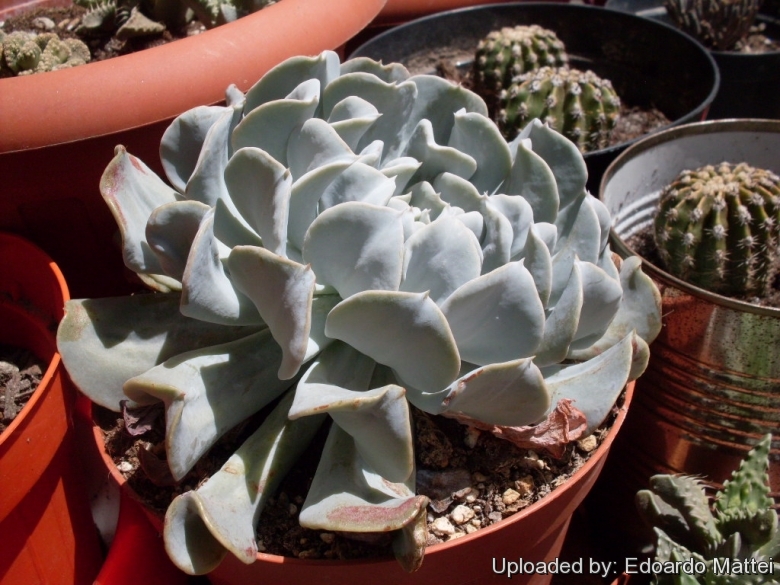
Echeveria cv. Topsy Turvy (Echeveria runyonii cv. Topsy Turvy) Photo by: Edoardo Mattei
Origin and Habitat: This cultivar is a mutation originated in cultivation in California. The standard Echeveria runyoniiSN|21873]]SN|21873]] is found natively in Mexico.
Synonyms:
Common Names include:
ENGLISH: Mexican Hens and Chicks Plant
CHINESE (中文): 特玉莲
Description: This is an interesting leaf form of Echeveria runyoniiSN|21873]]SN|21873]], which is a pale blue to white-blue leaf Echeveria with normal shaped leaves. However, this 'Topsy Turvy' form is much more popular, so the 'regular' form is quite rare in cultivation. It is a profuse offesetter and can create large mounds of densely crowded plants up to 20 x 35 cm (height by width). Parent plants can get up to 25 cm across, but rarely do the offsets.
Rosettes: Open and relatively untidy. The leaves are too narrow to form the perfect rosette usually expected in this genus.
Leaves: Up to 7,5 cm long by 2,5 cm across. Blue-green to silvery-grey often with pink tips, spatulate, strongly inversely keeled on the lower surface with leaf tips pointing inwards towards the centre of the plant. This leaves are some of the most unique curling and twisting leaves among the Echeverias, looking as if they are turned inside out.
Flowers: Showy bright orange, apricot and pink on tall arching racemes.
Blooming season: Usually in late Summer Autumn.
Subspecies, varieties, forms and cultivars of plants belonging to the Echeveria runyonii group
Notes: Echeveria runyoniiSN|21873]]SN|21873]] 'Topsy Turvy' is one of the true monstrous forms of Echeveria that 'breeds true' and won't revert back to it's natural form. There is also a crested form which is Echeveria runyoniiSN|21873]]SN|21873]] cv. Topsy Turvy f. cristata which can be reproduced only vegetatively. Only a fragment of the crested shoot is used for reproduction because leaves and normal shoots (non-crested) do not produce the crested trait.
Bibliography: Major references and further lectures
1) Forest & Kim Starr “Echeveria runyonii (Echevaria)”. Plants of Hawaii. <http://www.starrenvironmental.com>. Web. 27 Sep. 2014.
2) Gordon D. Rowley “The illustrated encyclopedia of succulents” Crown Publishers, 01/Aug/1978
3) Stuart Max Walters “The European Garden Flora: Dicotyledons” (Part I) Cambridge University Press, 1989
4) Eggli, Urs “Illustrated Handbook of Succulent Plants, Crassulaceae Illustrated Handbook of Succulent Plants.” Springer, Berlin 2002
5) Hermann Jacobsen “A handbook of succulent plants: descriptions, synonyms, and cultural details for succulents other than Cactaceae” Volume 1 Blandford Press, 1960
6) Werner Rauh “The Wonderful World of Succulents: Cultivation and Description of Selected Succulent Plants Other Than Cacti” Smithsonian Institution Press, 1984
7) San Marcos Growers contributors “Echeveria runyonii 'Topsy Turvy' San Marcos Growers <http://www.smgrowers.com>. Web. 27 Sep. 2014.
 Echeveria cv. Topsy Turvy (Echeveria runyonii cv. Topsy Turvy) Photo by: Edoardo Mattei
Echeveria cv. Topsy Turvy (Echeveria runyonii cv. Topsy Turvy) Photo by: Edoardo Mattei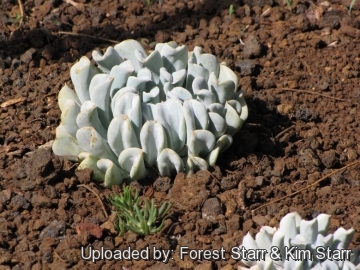 Habit at Enchanting Floral Gardens of Kula, Maui, Hawaii (USA). March 01, 2012. (Echeveria runyonii cv. Topsy Turvy) Photo by: Forest Starr & Kim Starr
Habit at Enchanting Floral Gardens of Kula, Maui, Hawaii (USA). March 01, 2012. (Echeveria runyonii cv. Topsy Turvy) Photo by: Forest Starr & Kim Starr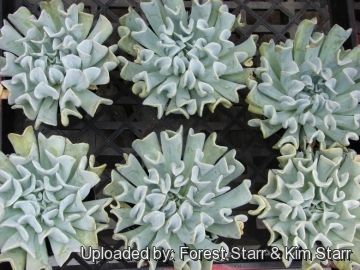 Topsy Turvy habit at Kula Ace Hardware and Nursery, Maui, Hawaii (USA). September 06, 2007. (Echeveria runyonii cv. Topsy Turvy) Photo by: Forest Starr & Kim Starr
Topsy Turvy habit at Kula Ace Hardware and Nursery, Maui, Hawaii (USA). September 06, 2007. (Echeveria runyonii cv. Topsy Turvy) Photo by: Forest Starr & Kim Starr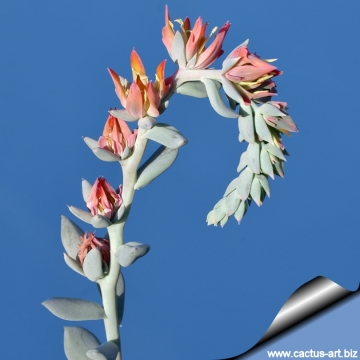 Echeveria cv. Topsy Turvy (Echeveria runyonii cv. Topsy Turvy) Photo by: Cactus Art
Echeveria cv. Topsy Turvy (Echeveria runyonii cv. Topsy Turvy) Photo by: Cactus Art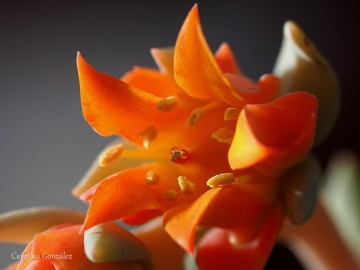 Nectar's drops... (Echeveria runyonii cv. Topsy Turvy) Photo by: Carolina González
Nectar's drops... (Echeveria runyonii cv. Topsy Turvy) Photo by: Carolina González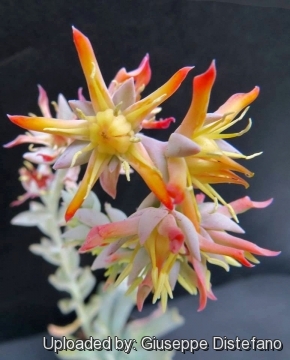 Echeveria cv. Topsy Turvy (Echeveria runyonii cv. Topsy Turvy) Photo by: Giuseppe Distefano
Echeveria cv. Topsy Turvy (Echeveria runyonii cv. Topsy Turvy) Photo by: Giuseppe Distefano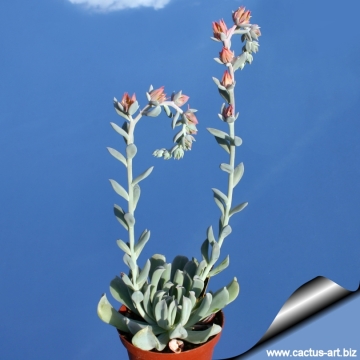 Echeveria cv. Topsy Turvy (Echeveria runyonii cv. Topsy Turvy) Photo by: Cactus Art
Echeveria cv. Topsy Turvy (Echeveria runyonii cv. Topsy Turvy) Photo by: Cactus Art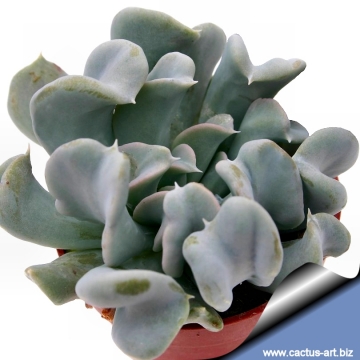 Echeveria cv. Topsy Turvy (Echeveria runyonii cv. Topsy Turvy) Photo by: Cactus Art
Echeveria cv. Topsy Turvy (Echeveria runyonii cv. Topsy Turvy) Photo by: Cactus ArtCultivation and Propagation: It can tolerate sun to shade but - generally speaking - the more light a plant gets the better it will display its colours and shape. However, when moving plants from lower light conditions into full sun, be wary of sun scorch, most easily avoided by ensuring plants are well-watered before moving them on a cloudy day. They can tolerate extended dry periods and survive drought without the need for watering, but they will grow stronger if they receive adequate moisture during their growing season, ut never allowing the plant to remain waterlogged (root rot sensitive). Use a very porous soil, which will allow quick drainage. Slow release fertilisers with a low to moderate nitrogen content are adequate for the spring and summer growing seasons, and additional fertiliser applications would not required until spring. Good air movement is important for minimising pest and disease risks, and avoiding excessive humidity in cool winter conditions is important to successfully growing Echeveria in the nursery environment. It can tolerate light frosts, but it is best overwintered at 5-10 °C.
With the cooler autumn temperatures tending to make their foliage colours become more intense than those of the active summer growing season.
Aphids like this plant (and all flowering Echeverias).
Propagation: Echeveria runyoniiSN|21873]]SN|21873]] 'Topsy Turvy' is usually propagated by removal of offset and by division of large clumps. Let the cut ends dry for overnight or up to a week before potting up. Some growers recommend planting immediately into dry growing media, watering only after roots form.
Your Photos

by Valentino Vallicelli

by Cactus Art
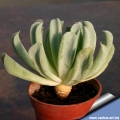
by Cactus Art
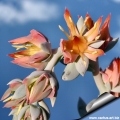
by Cactus Art






















